Managing People in Organizations
VerifiedAdded on 2023/01/13
|13
|3219
|59
AI Summary
This document discusses the importance of managing people in organizations. It covers topics such as recruitment and selection process, induction and training programs, motivation theories, and factors influencing individual behavior. The content provides insights into how organizations can effectively manage their employees.
Contribute Materials
Your contribution can guide someone’s learning journey. Share your
documents today.
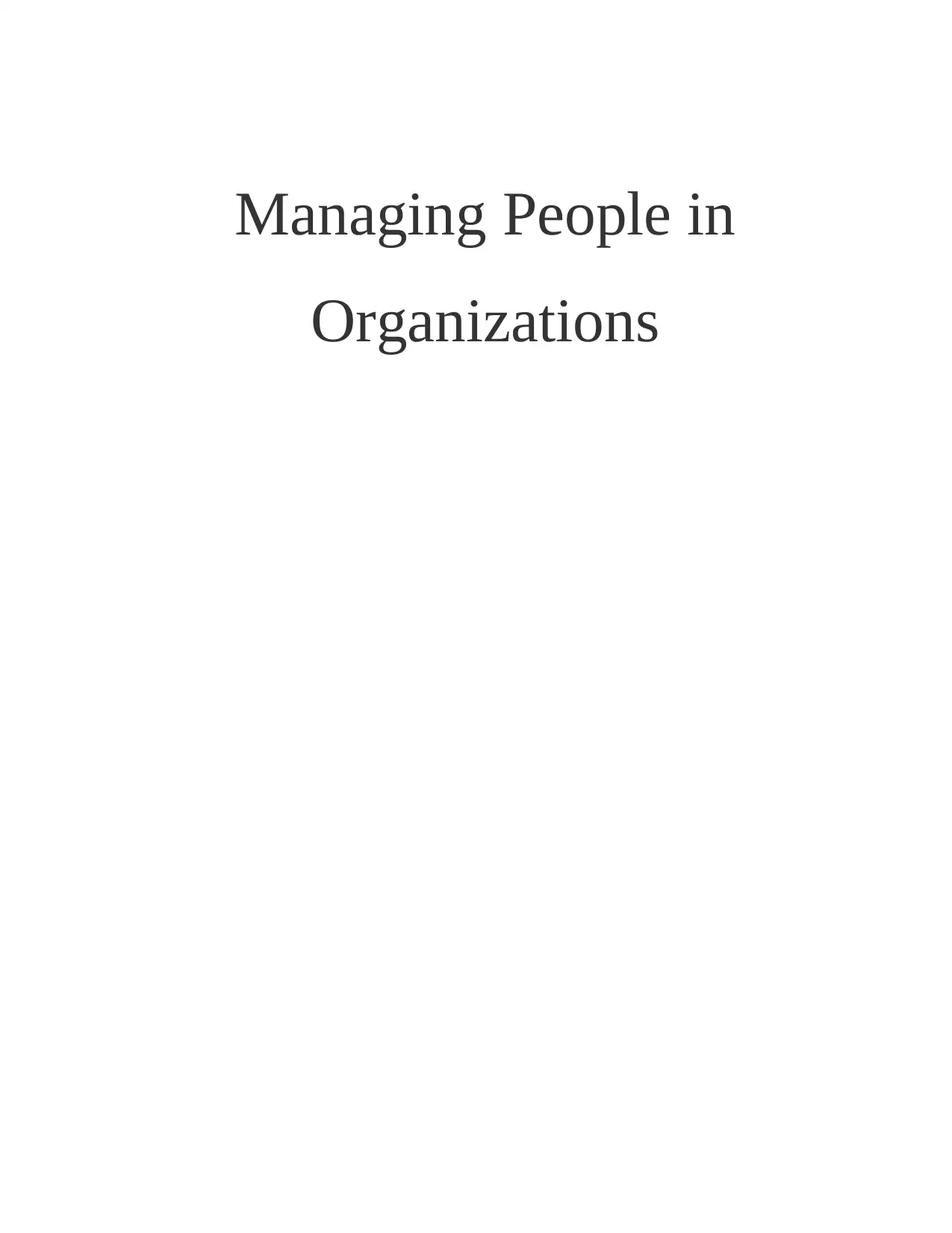
Managing People in
Organizations
Organizations
Secure Best Marks with AI Grader
Need help grading? Try our AI Grader for instant feedback on your assignments.
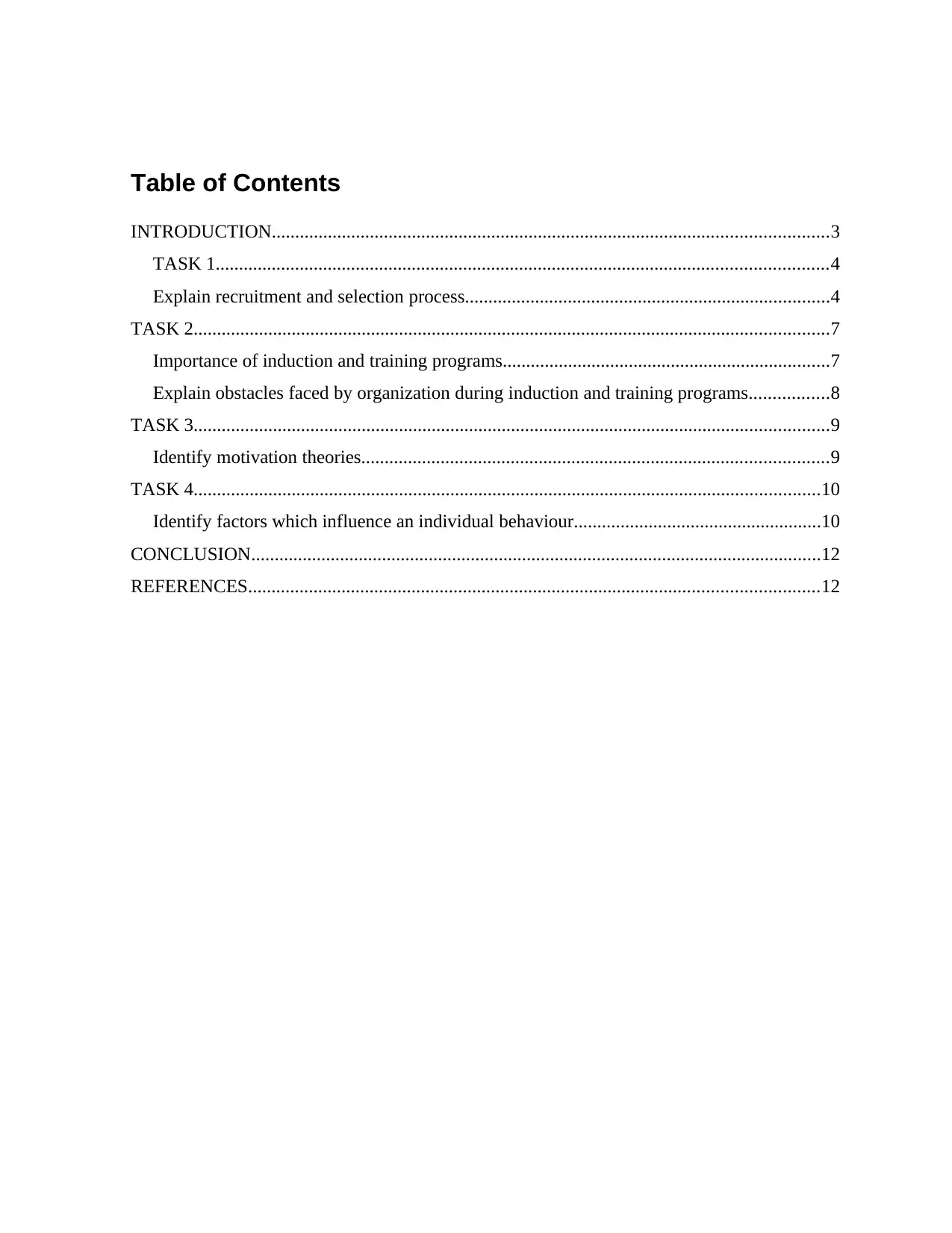
Table of Contents
INTRODUCTION.......................................................................................................................3
TASK 1...................................................................................................................................4
Explain recruitment and selection process..............................................................................4
TASK 2........................................................................................................................................7
Importance of induction and training programs......................................................................7
Explain obstacles faced by organization during induction and training programs.................8
TASK 3........................................................................................................................................9
Identify motivation theories....................................................................................................9
TASK 4......................................................................................................................................10
Identify factors which influence an individual behaviour.....................................................10
CONCLUSION..........................................................................................................................12
REFERENCES..........................................................................................................................12
INTRODUCTION.......................................................................................................................3
TASK 1...................................................................................................................................4
Explain recruitment and selection process..............................................................................4
TASK 2........................................................................................................................................7
Importance of induction and training programs......................................................................7
Explain obstacles faced by organization during induction and training programs.................8
TASK 3........................................................................................................................................9
Identify motivation theories....................................................................................................9
TASK 4......................................................................................................................................10
Identify factors which influence an individual behaviour.....................................................10
CONCLUSION..........................................................................................................................12
REFERENCES..........................................................................................................................12
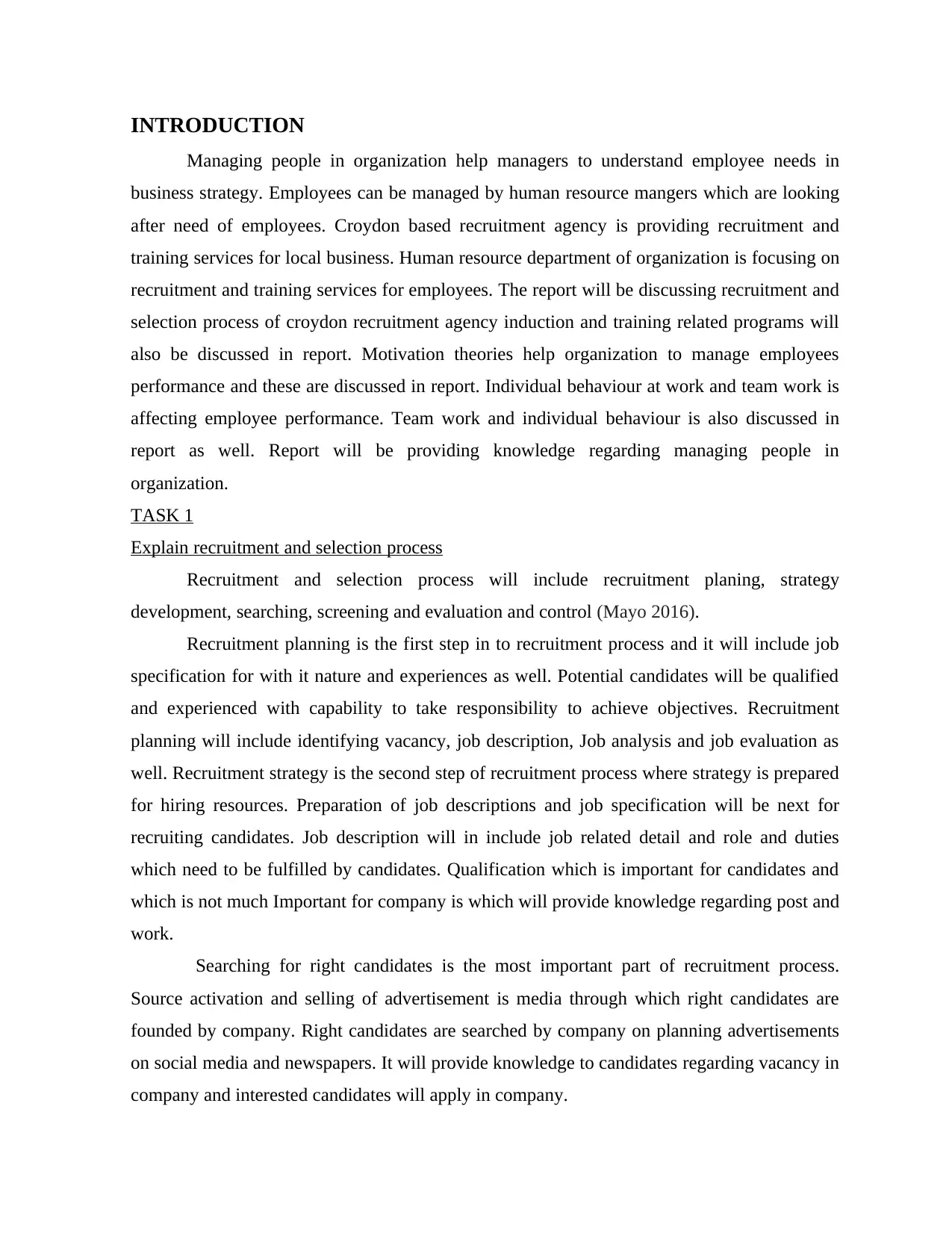
INTRODUCTION
Managing people in organization help managers to understand employee needs in
business strategy. Employees can be managed by human resource mangers which are looking
after need of employees. Croydon based recruitment agency is providing recruitment and
training services for local business. Human resource department of organization is focusing on
recruitment and training services for employees. The report will be discussing recruitment and
selection process of croydon recruitment agency induction and training related programs will
also be discussed in report. Motivation theories help organization to manage employees
performance and these are discussed in report. Individual behaviour at work and team work is
affecting employee performance. Team work and individual behaviour is also discussed in
report as well. Report will be providing knowledge regarding managing people in
organization.
TASK 1
Explain recruitment and selection process
Recruitment and selection process will include recruitment planing, strategy
development, searching, screening and evaluation and control (Mayo 2016).
Recruitment planning is the first step in to recruitment process and it will include job
specification for with it nature and experiences as well. Potential candidates will be qualified
and experienced with capability to take responsibility to achieve objectives. Recruitment
planning will include identifying vacancy, job description, Job analysis and job evaluation as
well. Recruitment strategy is the second step of recruitment process where strategy is prepared
for hiring resources. Preparation of job descriptions and job specification will be next for
recruiting candidates. Job description will in include job related detail and role and duties
which need to be fulfilled by candidates. Qualification which is important for candidates and
which is not much Important for company is which will provide knowledge regarding post and
work.
Searching for right candidates is the most important part of recruitment process.
Source activation and selling of advertisement is media through which right candidates are
founded by company. Right candidates are searched by company on planning advertisements
on social media and newspapers. It will provide knowledge to candidates regarding vacancy in
company and interested candidates will apply in company.
Managing people in organization help managers to understand employee needs in
business strategy. Employees can be managed by human resource mangers which are looking
after need of employees. Croydon based recruitment agency is providing recruitment and
training services for local business. Human resource department of organization is focusing on
recruitment and training services for employees. The report will be discussing recruitment and
selection process of croydon recruitment agency induction and training related programs will
also be discussed in report. Motivation theories help organization to manage employees
performance and these are discussed in report. Individual behaviour at work and team work is
affecting employee performance. Team work and individual behaviour is also discussed in
report as well. Report will be providing knowledge regarding managing people in
organization.
TASK 1
Explain recruitment and selection process
Recruitment and selection process will include recruitment planing, strategy
development, searching, screening and evaluation and control (Mayo 2016).
Recruitment planning is the first step in to recruitment process and it will include job
specification for with it nature and experiences as well. Potential candidates will be qualified
and experienced with capability to take responsibility to achieve objectives. Recruitment
planning will include identifying vacancy, job description, Job analysis and job evaluation as
well. Recruitment strategy is the second step of recruitment process where strategy is prepared
for hiring resources. Preparation of job descriptions and job specification will be next for
recruiting candidates. Job description will in include job related detail and role and duties
which need to be fulfilled by candidates. Qualification which is important for candidates and
which is not much Important for company is which will provide knowledge regarding post and
work.
Searching for right candidates is the most important part of recruitment process.
Source activation and selling of advertisement is media through which right candidates are
founded by company. Right candidates are searched by company on planning advertisements
on social media and newspapers. It will provide knowledge to candidates regarding vacancy in
company and interested candidates will apply in company.
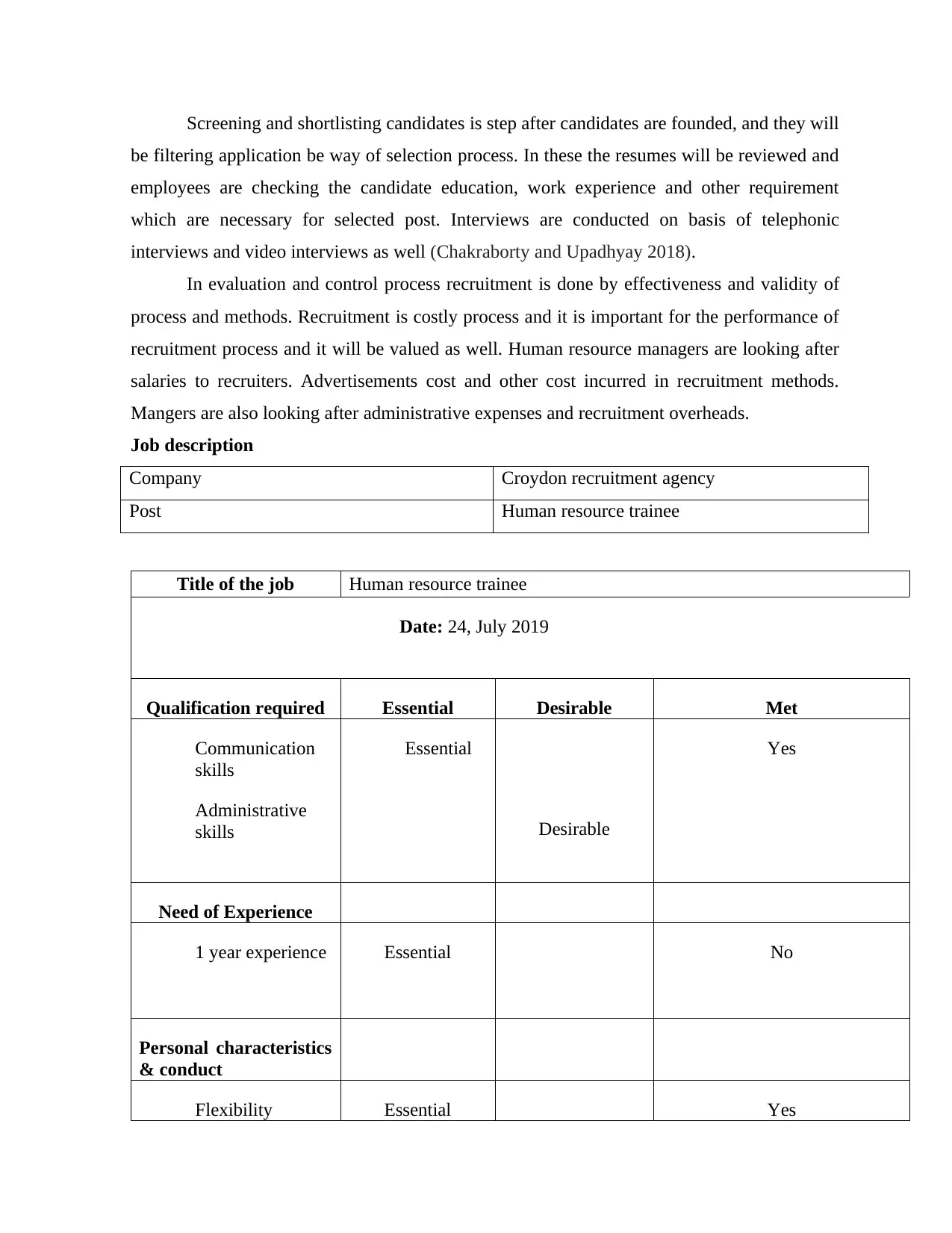
Screening and shortlisting candidates is step after candidates are founded, and they will
be filtering application be way of selection process. In these the resumes will be reviewed and
employees are checking the candidate education, work experience and other requirement
which are necessary for selected post. Interviews are conducted on basis of telephonic
interviews and video interviews as well (Chakraborty and Upadhyay 2018).
In evaluation and control process recruitment is done by effectiveness and validity of
process and methods. Recruitment is costly process and it is important for the performance of
recruitment process and it will be valued as well. Human resource managers are looking after
salaries to recruiters. Advertisements cost and other cost incurred in recruitment methods.
Mangers are also looking after administrative expenses and recruitment overheads.
Job description
Company Croydon recruitment agency
Post Human resource trainee
Title of the job Human resource trainee
Date: 24, July 2019
Qualification required Essential Desirable Met
Communication
skills
Administrative
skills
Essential
Desirable
Yes
Need of Experience
1 year experience Essential No
Personal characteristics
& conduct
Flexibility Essential Yes
be filtering application be way of selection process. In these the resumes will be reviewed and
employees are checking the candidate education, work experience and other requirement
which are necessary for selected post. Interviews are conducted on basis of telephonic
interviews and video interviews as well (Chakraborty and Upadhyay 2018).
In evaluation and control process recruitment is done by effectiveness and validity of
process and methods. Recruitment is costly process and it is important for the performance of
recruitment process and it will be valued as well. Human resource managers are looking after
salaries to recruiters. Advertisements cost and other cost incurred in recruitment methods.
Mangers are also looking after administrative expenses and recruitment overheads.
Job description
Company Croydon recruitment agency
Post Human resource trainee
Title of the job Human resource trainee
Date: 24, July 2019
Qualification required Essential Desirable Met
Communication
skills
Administrative
skills
Essential
Desirable
Yes
Need of Experience
1 year experience Essential No
Personal characteristics
& conduct
Flexibility Essential Yes
Secure Best Marks with AI Grader
Need help grading? Try our AI Grader for instant feedback on your assignments.
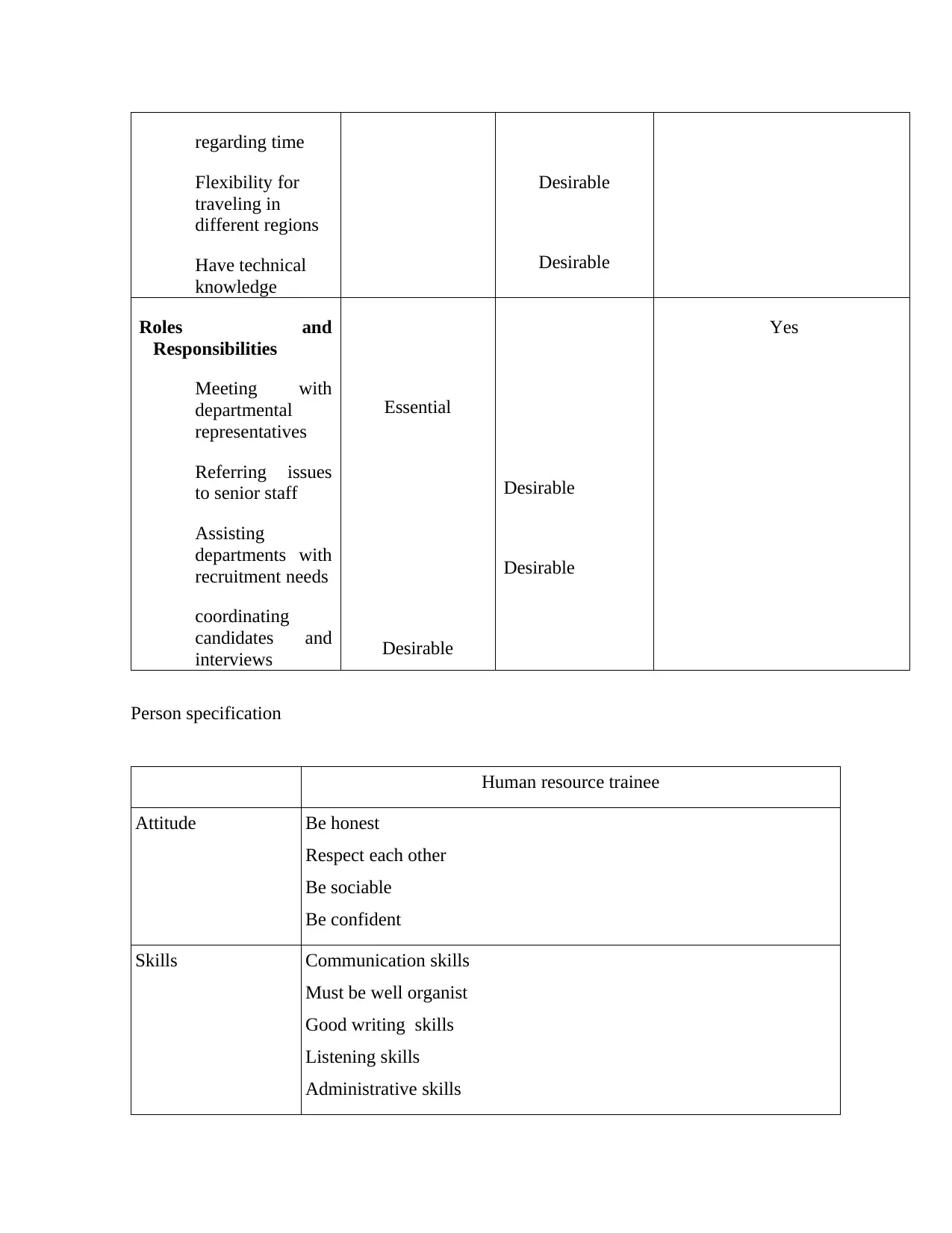
regarding time
Flexibility for
traveling in
different regions
Have technical
knowledge
Desirable
Desirable
Roles and
Responsibilities
Meeting with
departmental
representatives
Referring issues
to senior staff
Assisting
departments with
recruitment needs
coordinating
candidates and
interviews
Essential
Desirable
Desirable
Desirable
Yes
Person specification
Human resource trainee
Attitude Be honest
Respect each other
Be sociable
Be confident
Skills Communication skills
Must be well organist
Good writing skills
Listening skills
Administrative skills
Flexibility for
traveling in
different regions
Have technical
knowledge
Desirable
Desirable
Roles and
Responsibilities
Meeting with
departmental
representatives
Referring issues
to senior staff
Assisting
departments with
recruitment needs
coordinating
candidates and
interviews
Essential
Desirable
Desirable
Desirable
Yes
Person specification
Human resource trainee
Attitude Be honest
Respect each other
Be sociable
Be confident
Skills Communication skills
Must be well organist
Good writing skills
Listening skills
Administrative skills
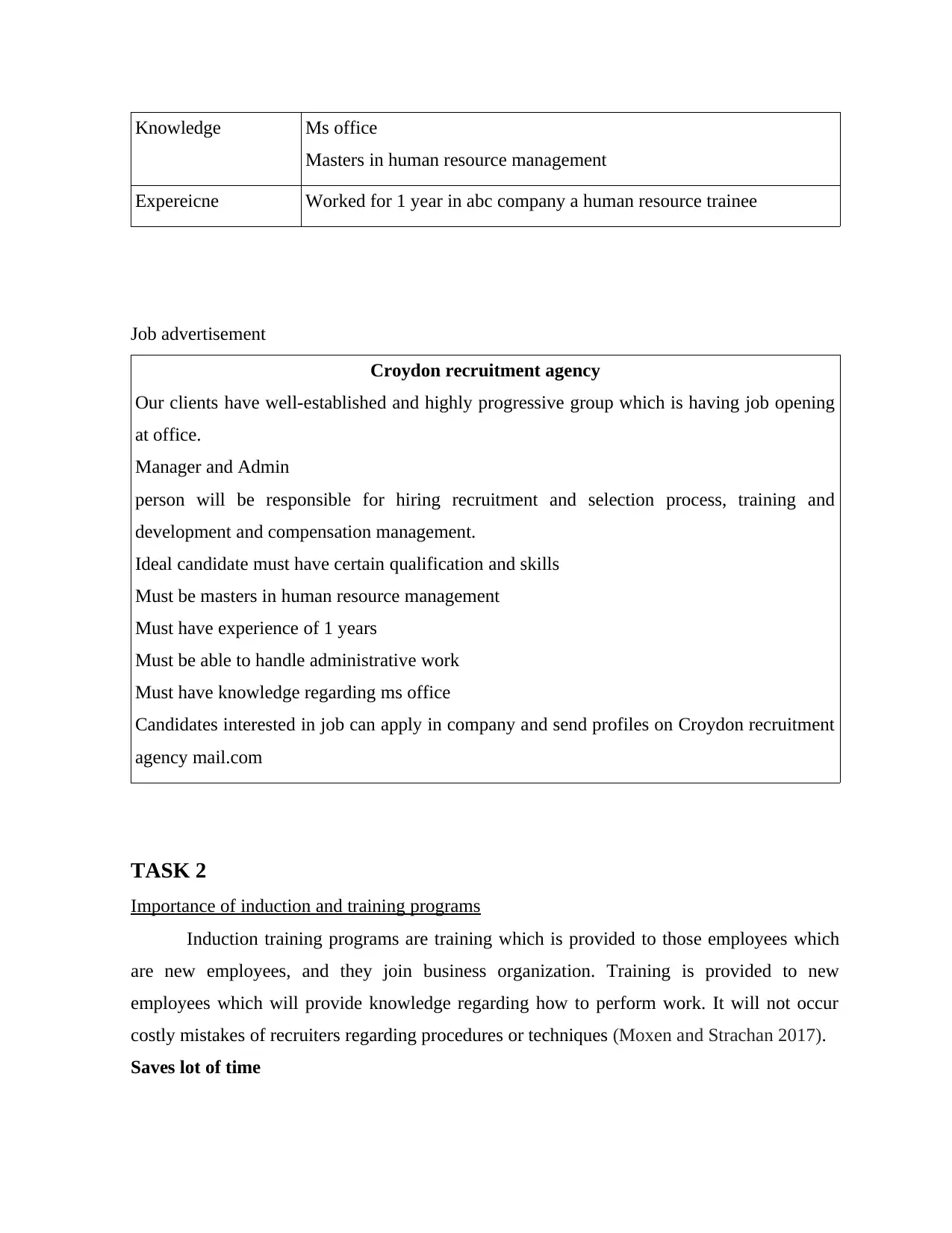
Knowledge Ms office
Masters in human resource management
Expereicne Worked for 1 year in abc company a human resource trainee
Job advertisement
Croydon recruitment agency
Our clients have well-established and highly progressive group which is having job opening
at office.
Manager and Admin
person will be responsible for hiring recruitment and selection process, training and
development and compensation management.
Ideal candidate must have certain qualification and skills
Must be masters in human resource management
Must have experience of 1 years
Must be able to handle administrative work
Must have knowledge regarding ms office
Candidates interested in job can apply in company and send profiles on Croydon recruitment
agency mail.com
TASK 2
Importance of induction and training programs
Induction training programs are training which is provided to those employees which
are new employees, and they join business organization. Training is provided to new
employees which will provide knowledge regarding how to perform work. It will not occur
costly mistakes of recruiters regarding procedures or techniques (Moxen and Strachan 2017).
Saves lot of time
Masters in human resource management
Expereicne Worked for 1 year in abc company a human resource trainee
Job advertisement
Croydon recruitment agency
Our clients have well-established and highly progressive group which is having job opening
at office.
Manager and Admin
person will be responsible for hiring recruitment and selection process, training and
development and compensation management.
Ideal candidate must have certain qualification and skills
Must be masters in human resource management
Must have experience of 1 years
Must be able to handle administrative work
Must have knowledge regarding ms office
Candidates interested in job can apply in company and send profiles on Croydon recruitment
agency mail.com
TASK 2
Importance of induction and training programs
Induction training programs are training which is provided to those employees which
are new employees, and they join business organization. Training is provided to new
employees which will provide knowledge regarding how to perform work. It will not occur
costly mistakes of recruiters regarding procedures or techniques (Moxen and Strachan 2017).
Saves lot of time
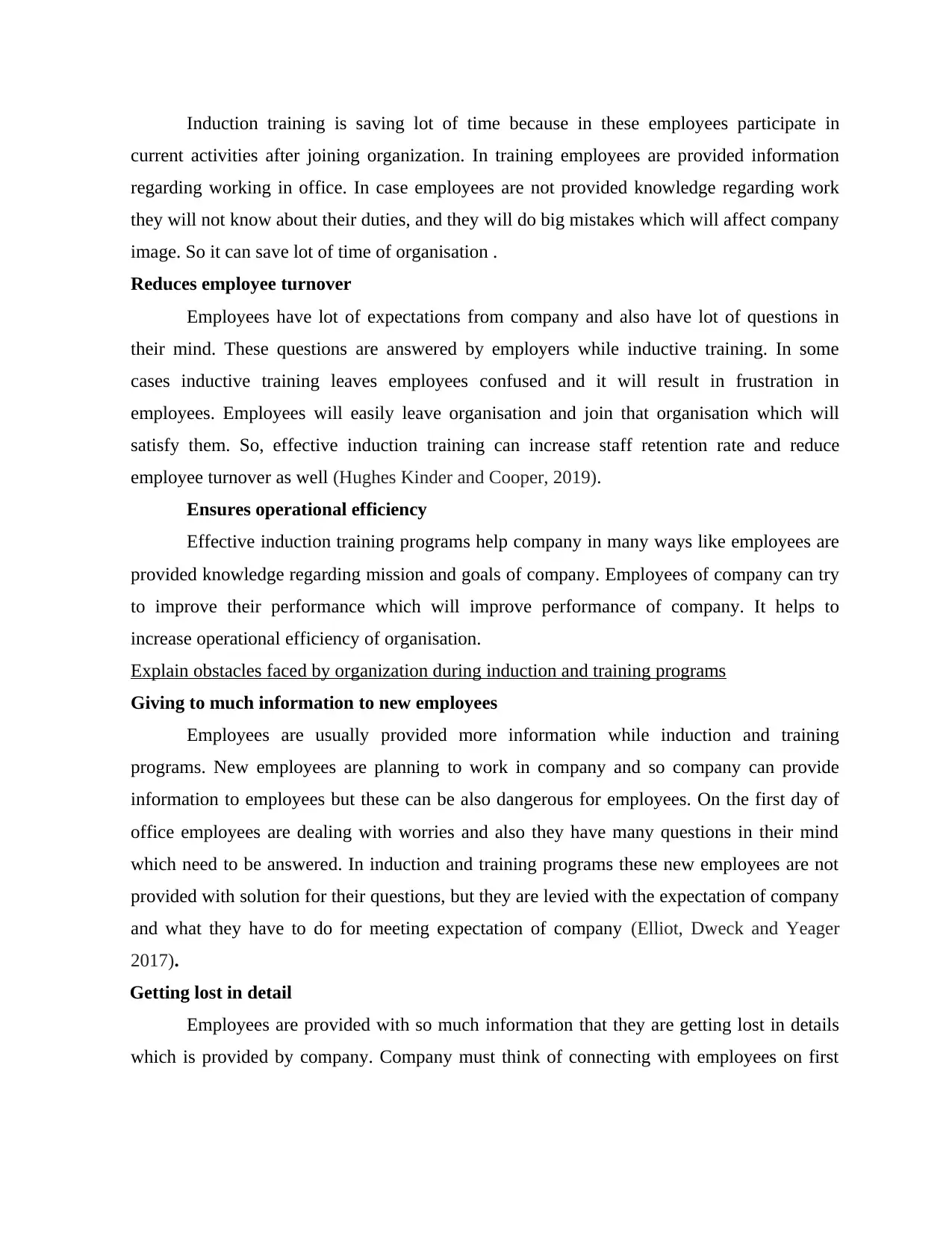
Induction training is saving lot of time because in these employees participate in
current activities after joining organization. In training employees are provided information
regarding working in office. In case employees are not provided knowledge regarding work
they will not know about their duties, and they will do big mistakes which will affect company
image. So it can save lot of time of organisation .
Reduces employee turnover
Employees have lot of expectations from company and also have lot of questions in
their mind. These questions are answered by employers while inductive training. In some
cases inductive training leaves employees confused and it will result in frustration in
employees. Employees will easily leave organisation and join that organisation which will
satisfy them. So, effective induction training can increase staff retention rate and reduce
employee turnover as well (Hughes Kinder and Cooper, 2019).
Ensures operational efficiency
Effective induction training programs help company in many ways like employees are
provided knowledge regarding mission and goals of company. Employees of company can try
to improve their performance which will improve performance of company. It helps to
increase operational efficiency of organisation.
Explain obstacles faced by organization during induction and training programs
Giving to much information to new employees
Employees are usually provided more information while induction and training
programs. New employees are planning to work in company and so company can provide
information to employees but these can be also dangerous for employees. On the first day of
office employees are dealing with worries and also they have many questions in their mind
which need to be answered. In induction and training programs these new employees are not
provided with solution for their questions, but they are levied with the expectation of company
and what they have to do for meeting expectation of company (Elliot, Dweck and Yeager
2017).
Getting lost in detail
Employees are provided with so much information that they are getting lost in details
which is provided by company. Company must think of connecting with employees on first
current activities after joining organization. In training employees are provided information
regarding working in office. In case employees are not provided knowledge regarding work
they will not know about their duties, and they will do big mistakes which will affect company
image. So it can save lot of time of organisation .
Reduces employee turnover
Employees have lot of expectations from company and also have lot of questions in
their mind. These questions are answered by employers while inductive training. In some
cases inductive training leaves employees confused and it will result in frustration in
employees. Employees will easily leave organisation and join that organisation which will
satisfy them. So, effective induction training can increase staff retention rate and reduce
employee turnover as well (Hughes Kinder and Cooper, 2019).
Ensures operational efficiency
Effective induction training programs help company in many ways like employees are
provided knowledge regarding mission and goals of company. Employees of company can try
to improve their performance which will improve performance of company. It helps to
increase operational efficiency of organisation.
Explain obstacles faced by organization during induction and training programs
Giving to much information to new employees
Employees are usually provided more information while induction and training
programs. New employees are planning to work in company and so company can provide
information to employees but these can be also dangerous for employees. On the first day of
office employees are dealing with worries and also they have many questions in their mind
which need to be answered. In induction and training programs these new employees are not
provided with solution for their questions, but they are levied with the expectation of company
and what they have to do for meeting expectation of company (Elliot, Dweck and Yeager
2017).
Getting lost in detail
Employees are provided with so much information that they are getting lost in details
which is provided by company. Company must think of connecting with employees on first
Paraphrase This Document
Need a fresh take? Get an instant paraphrase of this document with our AI Paraphraser
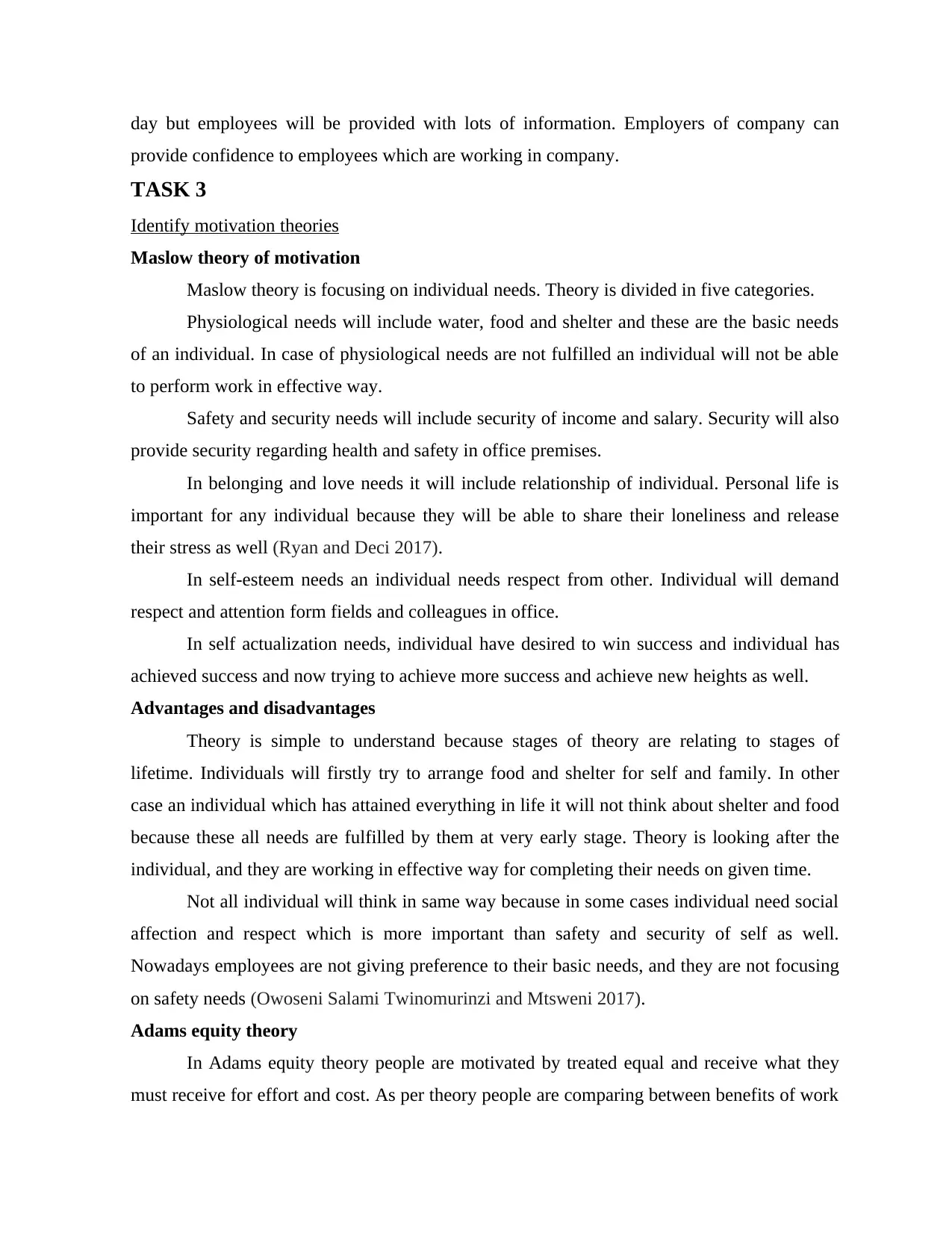
day but employees will be provided with lots of information. Employers of company can
provide confidence to employees which are working in company.
TASK 3
Identify motivation theories
Maslow theory of motivation
Maslow theory is focusing on individual needs. Theory is divided in five categories.
Physiological needs will include water, food and shelter and these are the basic needs
of an individual. In case of physiological needs are not fulfilled an individual will not be able
to perform work in effective way.
Safety and security needs will include security of income and salary. Security will also
provide security regarding health and safety in office premises.
In belonging and love needs it will include relationship of individual. Personal life is
important for any individual because they will be able to share their loneliness and release
their stress as well (Ryan and Deci 2017).
In self-esteem needs an individual needs respect from other. Individual will demand
respect and attention form fields and colleagues in office.
In self actualization needs, individual have desired to win success and individual has
achieved success and now trying to achieve more success and achieve new heights as well.
Advantages and disadvantages
Theory is simple to understand because stages of theory are relating to stages of
lifetime. Individuals will firstly try to arrange food and shelter for self and family. In other
case an individual which has attained everything in life it will not think about shelter and food
because these all needs are fulfilled by them at very early stage. Theory is looking after the
individual, and they are working in effective way for completing their needs on given time.
Not all individual will think in same way because in some cases individual need social
affection and respect which is more important than safety and security of self as well.
Nowadays employees are not giving preference to their basic needs, and they are not focusing
on safety needs (Owoseni Salami Twinomurinzi and Mtsweni 2017).
Adams equity theory
In Adams equity theory people are motivated by treated equal and receive what they
must receive for effort and cost. As per theory people are comparing between benefits of work
provide confidence to employees which are working in company.
TASK 3
Identify motivation theories
Maslow theory of motivation
Maslow theory is focusing on individual needs. Theory is divided in five categories.
Physiological needs will include water, food and shelter and these are the basic needs
of an individual. In case of physiological needs are not fulfilled an individual will not be able
to perform work in effective way.
Safety and security needs will include security of income and salary. Security will also
provide security regarding health and safety in office premises.
In belonging and love needs it will include relationship of individual. Personal life is
important for any individual because they will be able to share their loneliness and release
their stress as well (Ryan and Deci 2017).
In self-esteem needs an individual needs respect from other. Individual will demand
respect and attention form fields and colleagues in office.
In self actualization needs, individual have desired to win success and individual has
achieved success and now trying to achieve more success and achieve new heights as well.
Advantages and disadvantages
Theory is simple to understand because stages of theory are relating to stages of
lifetime. Individuals will firstly try to arrange food and shelter for self and family. In other
case an individual which has attained everything in life it will not think about shelter and food
because these all needs are fulfilled by them at very early stage. Theory is looking after the
individual, and they are working in effective way for completing their needs on given time.
Not all individual will think in same way because in some cases individual need social
affection and respect which is more important than safety and security of self as well.
Nowadays employees are not giving preference to their basic needs, and they are not focusing
on safety needs (Owoseni Salami Twinomurinzi and Mtsweni 2017).
Adams equity theory
In Adams equity theory people are motivated by treated equal and receive what they
must receive for effort and cost. As per theory people are comparing between benefits of work
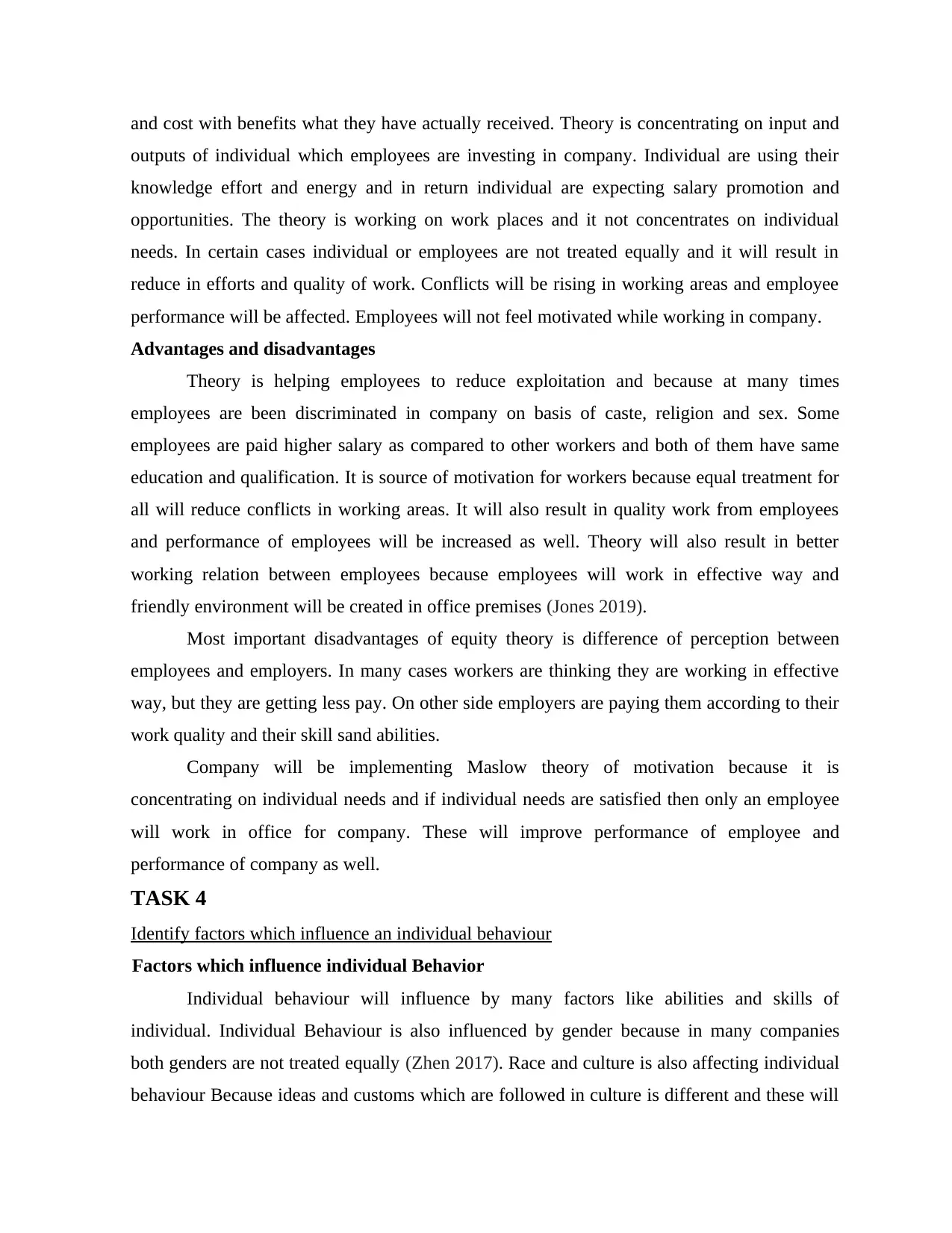
and cost with benefits what they have actually received. Theory is concentrating on input and
outputs of individual which employees are investing in company. Individual are using their
knowledge effort and energy and in return individual are expecting salary promotion and
opportunities. The theory is working on work places and it not concentrates on individual
needs. In certain cases individual or employees are not treated equally and it will result in
reduce in efforts and quality of work. Conflicts will be rising in working areas and employee
performance will be affected. Employees will not feel motivated while working in company.
Advantages and disadvantages
Theory is helping employees to reduce exploitation and because at many times
employees are been discriminated in company on basis of caste, religion and sex. Some
employees are paid higher salary as compared to other workers and both of them have same
education and qualification. It is source of motivation for workers because equal treatment for
all will reduce conflicts in working areas. It will also result in quality work from employees
and performance of employees will be increased as well. Theory will also result in better
working relation between employees because employees will work in effective way and
friendly environment will be created in office premises (Jones 2019).
Most important disadvantages of equity theory is difference of perception between
employees and employers. In many cases workers are thinking they are working in effective
way, but they are getting less pay. On other side employers are paying them according to their
work quality and their skill sand abilities.
Company will be implementing Maslow theory of motivation because it is
concentrating on individual needs and if individual needs are satisfied then only an employee
will work in office for company. These will improve performance of employee and
performance of company as well.
TASK 4
Identify factors which influence an individual behaviour
Factors which influence individual Behavior
Individual behaviour will influence by many factors like abilities and skills of
individual. Individual Behaviour is also influenced by gender because in many companies
both genders are not treated equally (Zhen 2017). Race and culture is also affecting individual
behaviour Because ideas and customs which are followed in culture is different and these will
outputs of individual which employees are investing in company. Individual are using their
knowledge effort and energy and in return individual are expecting salary promotion and
opportunities. The theory is working on work places and it not concentrates on individual
needs. In certain cases individual or employees are not treated equally and it will result in
reduce in efforts and quality of work. Conflicts will be rising in working areas and employee
performance will be affected. Employees will not feel motivated while working in company.
Advantages and disadvantages
Theory is helping employees to reduce exploitation and because at many times
employees are been discriminated in company on basis of caste, religion and sex. Some
employees are paid higher salary as compared to other workers and both of them have same
education and qualification. It is source of motivation for workers because equal treatment for
all will reduce conflicts in working areas. It will also result in quality work from employees
and performance of employees will be increased as well. Theory will also result in better
working relation between employees because employees will work in effective way and
friendly environment will be created in office premises (Jones 2019).
Most important disadvantages of equity theory is difference of perception between
employees and employers. In many cases workers are thinking they are working in effective
way, but they are getting less pay. On other side employers are paying them according to their
work quality and their skill sand abilities.
Company will be implementing Maslow theory of motivation because it is
concentrating on individual needs and if individual needs are satisfied then only an employee
will work in office for company. These will improve performance of employee and
performance of company as well.
TASK 4
Identify factors which influence an individual behaviour
Factors which influence individual Behavior
Individual behaviour will influence by many factors like abilities and skills of
individual. Individual Behaviour is also influenced by gender because in many companies
both genders are not treated equally (Zhen 2017). Race and culture is also affecting individual
behaviour Because ideas and customs which are followed in culture is different and these will
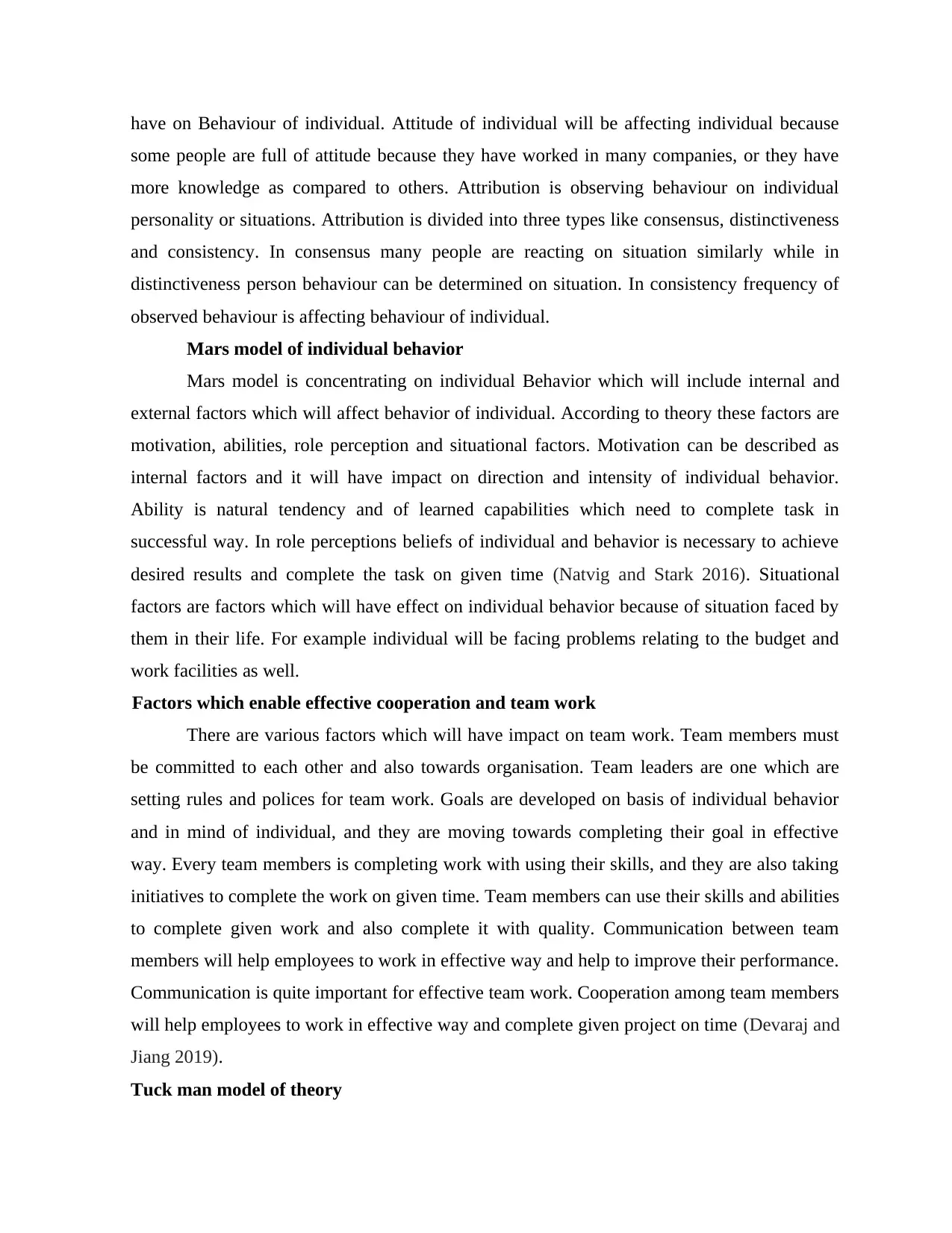
have on Behaviour of individual. Attitude of individual will be affecting individual because
some people are full of attitude because they have worked in many companies, or they have
more knowledge as compared to others. Attribution is observing behaviour on individual
personality or situations. Attribution is divided into three types like consensus, distinctiveness
and consistency. In consensus many people are reacting on situation similarly while in
distinctiveness person behaviour can be determined on situation. In consistency frequency of
observed behaviour is affecting behaviour of individual.
Mars model of individual behavior
Mars model is concentrating on individual Behavior which will include internal and
external factors which will affect behavior of individual. According to theory these factors are
motivation, abilities, role perception and situational factors. Motivation can be described as
internal factors and it will have impact on direction and intensity of individual behavior.
Ability is natural tendency and of learned capabilities which need to complete task in
successful way. In role perceptions beliefs of individual and behavior is necessary to achieve
desired results and complete the task on given time (Natvig and Stark 2016). Situational
factors are factors which will have effect on individual behavior because of situation faced by
them in their life. For example individual will be facing problems relating to the budget and
work facilities as well.
Factors which enable effective cooperation and team work
There are various factors which will have impact on team work. Team members must
be committed to each other and also towards organisation. Team leaders are one which are
setting rules and polices for team work. Goals are developed on basis of individual behavior
and in mind of individual, and they are moving towards completing their goal in effective
way. Every team members is completing work with using their skills, and they are also taking
initiatives to complete the work on given time. Team members can use their skills and abilities
to complete given work and also complete it with quality. Communication between team
members will help employees to work in effective way and help to improve their performance.
Communication is quite important for effective team work. Cooperation among team members
will help employees to work in effective way and complete given project on time (Devaraj and
Jiang 2019).
Tuck man model of theory
some people are full of attitude because they have worked in many companies, or they have
more knowledge as compared to others. Attribution is observing behaviour on individual
personality or situations. Attribution is divided into three types like consensus, distinctiveness
and consistency. In consensus many people are reacting on situation similarly while in
distinctiveness person behaviour can be determined on situation. In consistency frequency of
observed behaviour is affecting behaviour of individual.
Mars model of individual behavior
Mars model is concentrating on individual Behavior which will include internal and
external factors which will affect behavior of individual. According to theory these factors are
motivation, abilities, role perception and situational factors. Motivation can be described as
internal factors and it will have impact on direction and intensity of individual behavior.
Ability is natural tendency and of learned capabilities which need to complete task in
successful way. In role perceptions beliefs of individual and behavior is necessary to achieve
desired results and complete the task on given time (Natvig and Stark 2016). Situational
factors are factors which will have effect on individual behavior because of situation faced by
them in their life. For example individual will be facing problems relating to the budget and
work facilities as well.
Factors which enable effective cooperation and team work
There are various factors which will have impact on team work. Team members must
be committed to each other and also towards organisation. Team leaders are one which are
setting rules and polices for team work. Goals are developed on basis of individual behavior
and in mind of individual, and they are moving towards completing their goal in effective
way. Every team members is completing work with using their skills, and they are also taking
initiatives to complete the work on given time. Team members can use their skills and abilities
to complete given work and also complete it with quality. Communication between team
members will help employees to work in effective way and help to improve their performance.
Communication is quite important for effective team work. Cooperation among team members
will help employees to work in effective way and complete given project on time (Devaraj and
Jiang 2019).
Tuck man model of theory
Secure Best Marks with AI Grader
Need help grading? Try our AI Grader for instant feedback on your assignments.
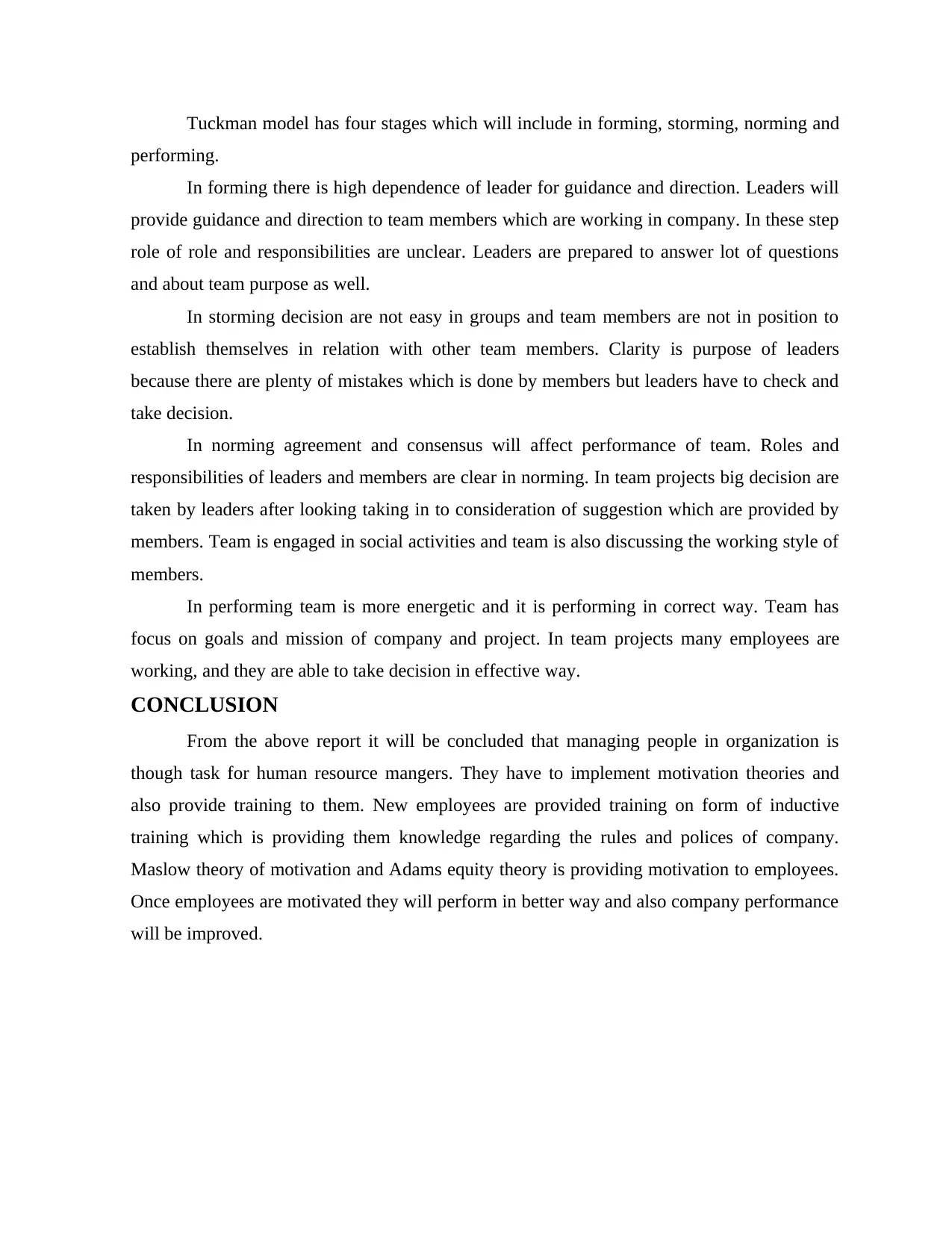
Tuckman model has four stages which will include in forming, storming, norming and
performing.
In forming there is high dependence of leader for guidance and direction. Leaders will
provide guidance and direction to team members which are working in company. In these step
role of role and responsibilities are unclear. Leaders are prepared to answer lot of questions
and about team purpose as well.
In storming decision are not easy in groups and team members are not in position to
establish themselves in relation with other team members. Clarity is purpose of leaders
because there are plenty of mistakes which is done by members but leaders have to check and
take decision.
In norming agreement and consensus will affect performance of team. Roles and
responsibilities of leaders and members are clear in norming. In team projects big decision are
taken by leaders after looking taking in to consideration of suggestion which are provided by
members. Team is engaged in social activities and team is also discussing the working style of
members.
In performing team is more energetic and it is performing in correct way. Team has
focus on goals and mission of company and project. In team projects many employees are
working, and they are able to take decision in effective way.
CONCLUSION
From the above report it will be concluded that managing people in organization is
though task for human resource mangers. They have to implement motivation theories and
also provide training to them. New employees are provided training on form of inductive
training which is providing them knowledge regarding the rules and polices of company.
Maslow theory of motivation and Adams equity theory is providing motivation to employees.
Once employees are motivated they will perform in better way and also company performance
will be improved.
performing.
In forming there is high dependence of leader for guidance and direction. Leaders will
provide guidance and direction to team members which are working in company. In these step
role of role and responsibilities are unclear. Leaders are prepared to answer lot of questions
and about team purpose as well.
In storming decision are not easy in groups and team members are not in position to
establish themselves in relation with other team members. Clarity is purpose of leaders
because there are plenty of mistakes which is done by members but leaders have to check and
take decision.
In norming agreement and consensus will affect performance of team. Roles and
responsibilities of leaders and members are clear in norming. In team projects big decision are
taken by leaders after looking taking in to consideration of suggestion which are provided by
members. Team is engaged in social activities and team is also discussing the working style of
members.
In performing team is more energetic and it is performing in correct way. Team has
focus on goals and mission of company and project. In team projects many employees are
working, and they are able to take decision in effective way.
CONCLUSION
From the above report it will be concluded that managing people in organization is
though task for human resource mangers. They have to implement motivation theories and
also provide training to them. New employees are provided training on form of inductive
training which is providing them knowledge regarding the rules and polices of company.
Maslow theory of motivation and Adams equity theory is providing motivation to employees.
Once employees are motivated they will perform in better way and also company performance
will be improved.

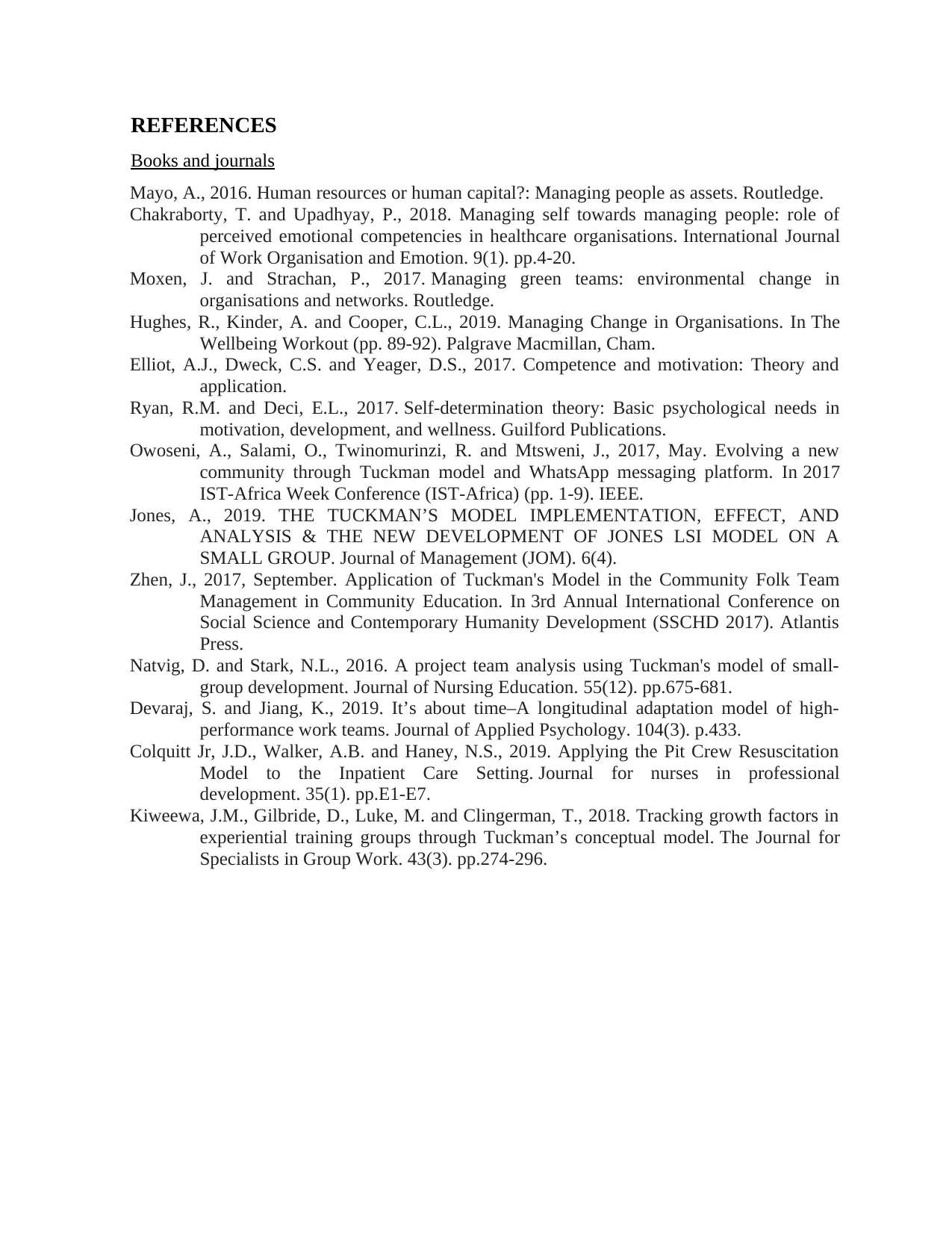
REFERENCES
Books and journals
Mayo, A., 2016. Human resources or human capital?: Managing people as assets. Routledge.
Chakraborty, T. and Upadhyay, P., 2018. Managing self towards managing people: role of
perceived emotional competencies in healthcare organisations. International Journal
of Work Organisation and Emotion. 9(1). pp.4-20.
Moxen, J. and Strachan, P., 2017. Managing green teams: environmental change in
organisations and networks. Routledge.
Hughes, R., Kinder, A. and Cooper, C.L., 2019. Managing Change in Organisations. In The
Wellbeing Workout (pp. 89-92). Palgrave Macmillan, Cham.
Elliot, A.J., Dweck, C.S. and Yeager, D.S., 2017. Competence and motivation: Theory and
application.
Ryan, R.M. and Deci, E.L., 2017. Self-determination theory: Basic psychological needs in
motivation, development, and wellness. Guilford Publications.
Owoseni, A., Salami, O., Twinomurinzi, R. and Mtsweni, J., 2017, May. Evolving a new
community through Tuckman model and WhatsApp messaging platform. In 2017
IST-Africa Week Conference (IST-Africa) (pp. 1-9). IEEE.
Jones, A., 2019. THE TUCKMAN’S MODEL IMPLEMENTATION, EFFECT, AND
ANALYSIS & THE NEW DEVELOPMENT OF JONES LSI MODEL ON A
SMALL GROUP. Journal of Management (JOM). 6(4).
Zhen, J., 2017, September. Application of Tuckman's Model in the Community Folk Team
Management in Community Education. In 3rd Annual International Conference on
Social Science and Contemporary Humanity Development (SSCHD 2017). Atlantis
Press.
Natvig, D. and Stark, N.L., 2016. A project team analysis using Tuckman's model of small-
group development. Journal of Nursing Education. 55(12). pp.675-681.
Devaraj, S. and Jiang, K., 2019. It’s about time–A longitudinal adaptation model of high-
performance work teams. Journal of Applied Psychology. 104(3). p.433.
Colquitt Jr, J.D., Walker, A.B. and Haney, N.S., 2019. Applying the Pit Crew Resuscitation
Model to the Inpatient Care Setting. Journal for nurses in professional
development. 35(1). pp.E1-E7.
Kiweewa, J.M., Gilbride, D., Luke, M. and Clingerman, T., 2018. Tracking growth factors in
experiential training groups through Tuckman’s conceptual model. The Journal for
Specialists in Group Work. 43(3). pp.274-296.
Books and journals
Mayo, A., 2016. Human resources or human capital?: Managing people as assets. Routledge.
Chakraborty, T. and Upadhyay, P., 2018. Managing self towards managing people: role of
perceived emotional competencies in healthcare organisations. International Journal
of Work Organisation and Emotion. 9(1). pp.4-20.
Moxen, J. and Strachan, P., 2017. Managing green teams: environmental change in
organisations and networks. Routledge.
Hughes, R., Kinder, A. and Cooper, C.L., 2019. Managing Change in Organisations. In The
Wellbeing Workout (pp. 89-92). Palgrave Macmillan, Cham.
Elliot, A.J., Dweck, C.S. and Yeager, D.S., 2017. Competence and motivation: Theory and
application.
Ryan, R.M. and Deci, E.L., 2017. Self-determination theory: Basic psychological needs in
motivation, development, and wellness. Guilford Publications.
Owoseni, A., Salami, O., Twinomurinzi, R. and Mtsweni, J., 2017, May. Evolving a new
community through Tuckman model and WhatsApp messaging platform. In 2017
IST-Africa Week Conference (IST-Africa) (pp. 1-9). IEEE.
Jones, A., 2019. THE TUCKMAN’S MODEL IMPLEMENTATION, EFFECT, AND
ANALYSIS & THE NEW DEVELOPMENT OF JONES LSI MODEL ON A
SMALL GROUP. Journal of Management (JOM). 6(4).
Zhen, J., 2017, September. Application of Tuckman's Model in the Community Folk Team
Management in Community Education. In 3rd Annual International Conference on
Social Science and Contemporary Humanity Development (SSCHD 2017). Atlantis
Press.
Natvig, D. and Stark, N.L., 2016. A project team analysis using Tuckman's model of small-
group development. Journal of Nursing Education. 55(12). pp.675-681.
Devaraj, S. and Jiang, K., 2019. It’s about time–A longitudinal adaptation model of high-
performance work teams. Journal of Applied Psychology. 104(3). p.433.
Colquitt Jr, J.D., Walker, A.B. and Haney, N.S., 2019. Applying the Pit Crew Resuscitation
Model to the Inpatient Care Setting. Journal for nurses in professional
development. 35(1). pp.E1-E7.
Kiweewa, J.M., Gilbride, D., Luke, M. and Clingerman, T., 2018. Tracking growth factors in
experiential training groups through Tuckman’s conceptual model. The Journal for
Specialists in Group Work. 43(3). pp.274-296.
1 out of 13
Related Documents
Your All-in-One AI-Powered Toolkit for Academic Success.
+13062052269
info@desklib.com
Available 24*7 on WhatsApp / Email
![[object Object]](/_next/static/media/star-bottom.7253800d.svg)
Unlock your academic potential
© 2024 | Zucol Services PVT LTD | All rights reserved.





